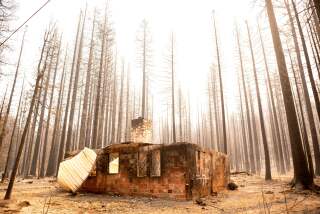Owners May Be Buying Needless Flood Insurance
California and other parts of the country are in the midst of a prolonged drought, but thousands of borrowers who’ve recently been told by their lenders that they have to buy expensive flood-insurance policies may be getting soaked.
“There are an awful lot of people here who are paying for flood-insurance that they don’t need,” said John Garamendi, California’s insurance commissioner. “And if it’s a big problem here in California, then it’s probably a big problem across the rest of the country.”
Most homeowners who live in “special flood-hazard areas” designated by the Federal Emergency Management Agency (FEMA) have been required to carry flood insurance since 1973, when Congress passed the Mandatory Flood Insurance Act.
However, lenders--who are responsible for making sure that their borrowers purchase the coverage--rarely enforced the law because it was difficult for them to determine which homes were in a flood zone and which ones weren’t.
Pressure to uphold the law began to build a few years ago, when government regulators first realized the severity of the savings and loan crisis.
Many lenders are now sending out thousands of notices each month, demanding that borrowers in flood zones obtain a flood-insurance policy within 60 days.
If a borrower refuses, the lender can either purchase a policy and bill the homeowner--a process known as “force-placing” insurance--or instigate foreclosure proceedings.
Meantime, new buyers who are moving to areas considered flood-prone by FEMA are being told that they’ll have to get the insurance if they want to get a loan.
“If you don’t get a policy and you’re in a flood zone, you don’t get the money,” summed up Tom Criser of the Lenders Center, a mortgage-broker in Thousand Oaks.
But the rush by lending institutions to enforce the flood-insurance rule has some regulators worried that many borrowers are paying hundreds of dollars a year for policies they don’t need.
Their concerns have been heightened because many cities across the country--including Los Angeles, Long Beach and Simi Valley--have recently approved new flood-zone maps that could classify thousands of more homes and businesses as being in flood-prone areas.
Many of the errors can be blamed on the data supplied by the various research firms that lenders or insurers often hire to determine which properties lie in flood areas, Garamendi said.
One of the biggest research firms, Electronic Data Systems Corp., claims to have made about 3.5 million flood-zone determinations for dozens of institutions in California and across the United States over the past two years.
Paul Webb, an EDS executive, said he’s confident that his company accurately determines whether a property is in a flood area more than 90% of the time.
“It’s almost impossible to be 100% accurate, partly because the earth is constantly shifting,” Webb said. “Flood zones can change every year, and a lot of times we have to base our determination on maps that don’t provide a lot of information.”
Still, even if EDS is accurate 95% of the time, it alone may have erroneously identified nearly 175,000 homes as being in flood zones in the past 24 months.
“Those are the people who are stuck paying for flood-insurance policies that they don’t need,” Garamendi said. “They’re wasting hundreds of dollars a year.”
Garamendi and his staff are revising some of the state’s insurance regulations in an effort to make the information that determines who lives in a flood zone and who doesn’t more reliable.
Under the revisions, brokers and agents who negligently sell insurance to homeowners who don’t need it would also be subject to a fine or could even have their licenses suspended or revoked.
In the meantime, here are some tips if you think that you’ve erroneously received a notice to buy flood insurance:
* Check with your local Public Works Department, Flood Control District or City Engineering Department to be sure that you’re really in a flood zone.
Some cities, including Los Angeles, will often tell whether you’re in a flood zone over the phone. To play it safe, though, you might want to personally visit the proper office and inspect the flood maps yourself.
* Remember that some homeowners don’t have to buy flood insurance, even if their property is in a flood zone.
For example, someone who owns a mini-ranch might be eligible for an exemption if most of the property is in a flood plain but the home itself is perched on a hill or knoll. Your lender or insurance agent can provide more details.
* If all your checking shows that you really are in a flood zone and a flood-insurance policy is required, see if you can get the coverage through the National Flood Insurance Program instead of buying it from a private company.
Most insurance agents can sell you a low-cost NFIP policy. “Since rates on the policies are set by the federal government, NFIP premiums are often a lot lower than premiums charged by private-sector insurers,” said Bill Zellars, a FEMA spokesman.
The NFIP’s toll-free consumer hot line is (800) 638-6620.
The California Department of Insurance also operates a toll-free hot line staffed with experts who can answer a variety of insurance-related questions. The number: (800) 927-4357.
Letters and questions may be sent to Myers at the Real Estate section, Los Angeles Times, Times Mirror Square, Los Angeles 90053. Questions cannot be answered individually.
More to Read
Inside the business of entertainment
The Wide Shot brings you news, analysis and insights on everything from streaming wars to production — and what it all means for the future.
You may occasionally receive promotional content from the Los Angeles Times.






